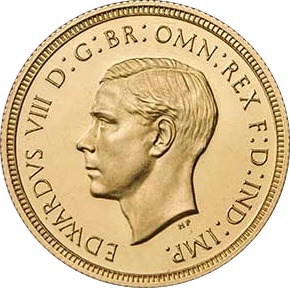
The public never got to hold any coins with the portrait of Edward VIII, but some coins did exist. This is the story of one of them.
Edward VIII became King on the death of his father, George V, on 20 January 1936. But by his own decision his reign lasted only 326 days. The public never got to hold any coins with the portrait of the new King – but some coins did exist.
Once a King or Queen is crowned, the Royal Mint starts the process of creating coins for the new Monarch. Preliminary sketches, designs, engravings, patterns and eventually a few trial coins are produced. Not for production or release to the public, but just to evaluate the new coins.
The process had gone that far. Just one complete set of coins. Six gold sovereigns were made. None released. They were dated 1937 as the production coins were due to be released on 1st January.
But there was a growing problem with the monarchy. Edward wanted to marry Wallis Simpson, a twice-divorced American. Parliament was against it and as the King is also head of the Church of England it was unacceptable (in 1936) to marry a divorcee.
Edward had another solution: he would no longer be King. So on 11 December 1936 he abdicated the throne and went on to marry Wallis. Edward’s younger brother became King George VI.
What happened to the Coins?
Edward did ask if he could have a set of the coins but George VI refused on the basis that they were not official as they had not passed through the Royal Proclamation process.
The lot were hidden away, there was no need to remind the public of such an embarrassing sequence of events. The coins seemed to disappear from existence until 1970 when a sealed cardboard box was found in an office safe at the Royal Mint; it contained 49 coins of Edward VIII.
The coins were placed in the Royal Mint Museum and over the next few years a few other coins were obtained from both private sellers and salerooms.

The Portrait was a Surprise
One thing which was unexpected was that Edward’s portrait faced left. The tradition is that monarch’s heads alternate facing right and left. George V faced left so Edward VIII should face right. Even George VI assumed the tradition had been maintained as his too faced left.
This anomaly was at the request of the Edward himself; he decided that his left side was more flattering as it showed the parting of his hair. He also chose the portrait by Humphrey Paget over that of William McMillan.
The Reverse shows Benedetto Pistrucci’s famous portrayal of St George and the dragon.
Tracking Down a Gold Sovereign
As only six of the pattern gold sovereigns were made then it follows that these are high value and a collectors dream. Three are in the Royal Mint Museum (although one is on long-term loan to the British Museum); One is in the Royal Collection; One is privately owned.
The other Edward VIII Gold Sovereign had been sold before. In 1984 it was sold for £40,000 in Tokyo and in 2014 was sold for £516,000 in an auction in London, a record price for a gold sovereign at the time.
The Royal Mint offers a public service to locate rare coins (for a fee) and was asked by a British collector to source, authenticate and broker a deal. The eventual price was £1 million, making it the most expensive gold sovereign ever.
Is it worth it? Without doubt, both as a coin and as an investment.
Images by permission of the Royal Mint.








